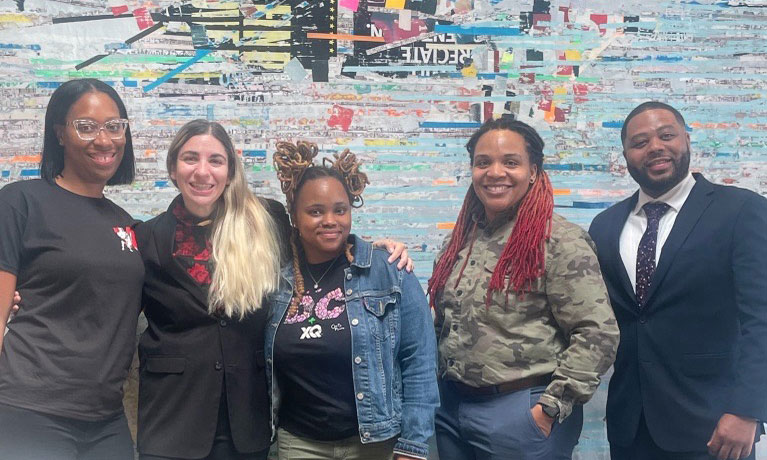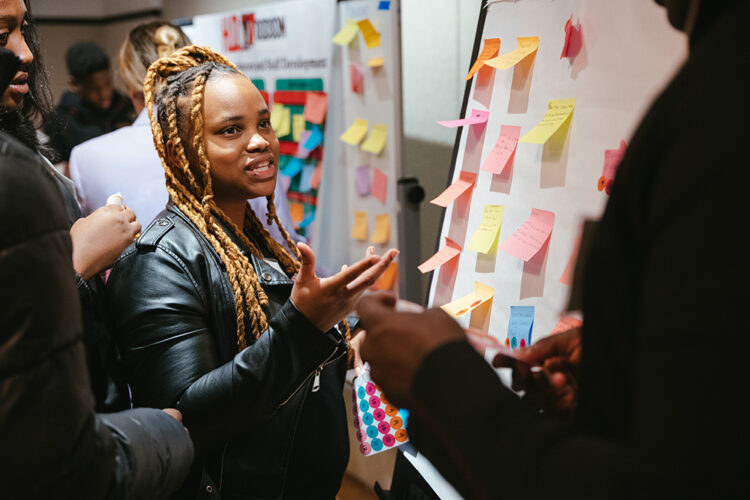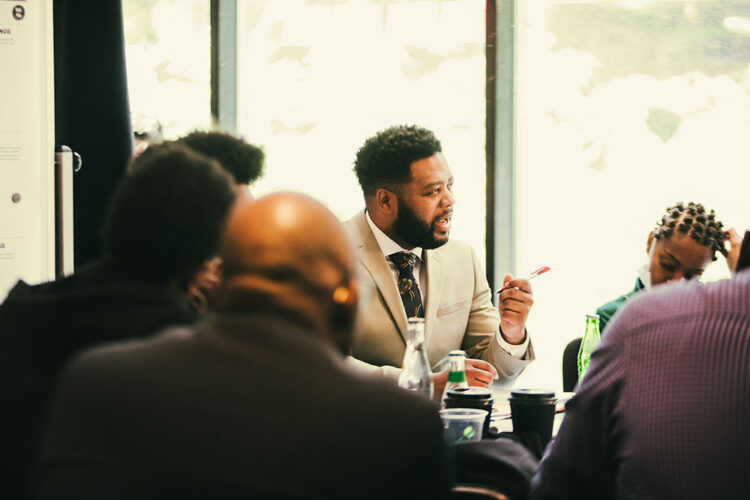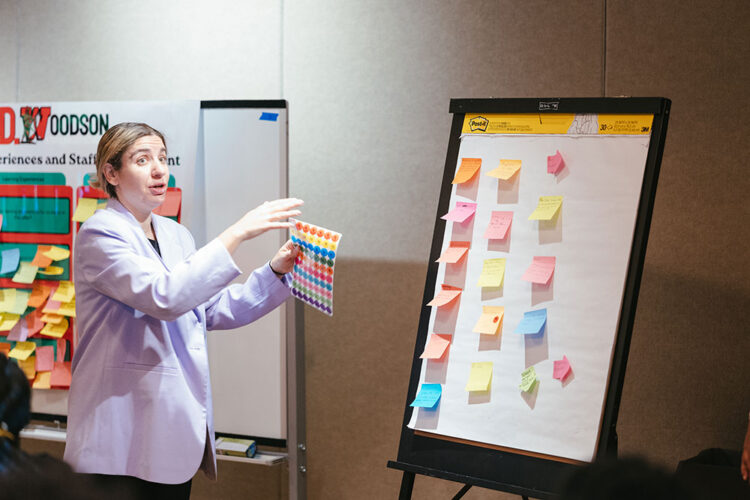How D.C. Successfully Redesigned a School By Embracing Its Legacy
To change the high school experience, H.D. Woodson High School is listening to its community.

Get stories like these delivered straight to your inbox. Sign up for The 74 Newsletter
This article has been produced in partnership between The 74 and the XQ Institute.
Just before the start of the new school year for D.C. Public Schools, dozens of people gathered under a bright August sun in the northeast neighborhood of Deanwood. They were there to celebrate the 50th anniversary of a local institution: H.D. Woodson High School. A prominent new street sign, reading “Woodson Way,” was unveiled directly in front of the campus, forever enshrining a legacy.
But this joyful event did more than just reflect on the high school’s storied history: it also set the stage for a bold new vision that’s reshaping the whole learning experience for both students and faculty.
The energy was infectious. A teacher’s choir performed and five decades of alumni, each displaying their graduation year on T-shirts, chanted school slogans. Speakers included a city council member, a founding teacher and a current Woodson student.
“What is the Woodson Way? We need to recommit to it,” said alumni council member John Cotten, Woodson High School Class of 1981.
This past summer, Woodson was among four DCPS high schools selected for DC+XQ, a multiyear partnership between DCPS and the XQ Institute that aims to make high school more meaningful and engaging for all learners so they’re better prepared for college and career. Woodson’s community united around a new theme for the school: cultivating and activating students’ passions so every graduate earns a career certification or an associate degree aligned with their interests.
Launching a redesign effort in a school with generations of tradition like Woodson is not simple. Neighborhood high schools carry memories for residents and alumni, who recall athletic teams and veteran teachers. The tangible camaraderie at Woodson’s anniversary event reflects a commitment to meeting a changing world with new educational experiences while still holding on to the fabric that makes a school what it is. Woodson’s journey also carries four major lessons for other high schools and their communities.
A new video series from XQ follows the journey of the DC+XQ schools and features the stories of the educators and leaders rethinking high school across D.C. Learn about the goals of the partnership and follow along as new videos are released each month.
1. Ground Your Goals in the Data
The DC+XQ partnership started in 2022. Participating schools create design teams and receive financial and professional support as they rethink learning from the ground up — hand-in-hand with their students and communities. Along the way, school teams meet with experts and visit other XQ high schools already deep in the transformation process.
The DC+XQ partnership also included a chance for schools to complete XQ’s Educational Opportunity Audit, a tool that examines student transcripts to shine a spotlight on long-standing inequities. The EOA helps design teams figure out which students in their high school are more prepared than others for college and career, often due to inequitable practices, to avoid replicating the same patterns. A previous audit in Rhode Island led the state to enact higher graduation standards.

In D.C., the EOA found that even schools with high graduation rates were not preparing all students for postsecondary success. To overcome these inequities, DCPS Chancellor Lewis Ferebee encouraged the city’s high schools to think big, without restraints.
“My responsibility is [to ensure] that the schools know they can go as bold as they need to give students the schools and learning experiences they deserve,” he explained. This could include changing traditional schedules and course offerings.
2. Build a Coalition
Woodson was founded by Howard Dilworth Woodson, one of the first Black licensed architectural engineers in D.C. and a powerful advocate for extending city services to this far, northeast corner of the city. Before the school opened in 1971, high schoolers in the Deanwood neighborhood had to travel three to five miles to the nearest campus. Woodson formed a broad coalition that pushed the city to pave and widen roads, build a new seven-story building and launch a public school lovingly nicknamed the “Tower of Power.”
But the Tower of Power suffered neglect and eventual demolition (a new Woodson building opened in 2011). The neighborhood also experienced gentrification and displacement. Meanwhile, the world was changing. Today’s students need different things from high school than they did 50 years ago.
Current Woodson Principal William Massey knew all this when he raised his hand in March of 2022 to join the DC+XQ design journey. He assembled a core team of a dozen diverse stakeholders, including students, teachers and community members, to respond to data from the EOA about student satisfaction and success and to define a new shared vision. But Massey acknowledged he was “very protective of the process.” He was concerned about how people in his school and neighborhood would respond to the phrase “high school redesign” after DCPS had undergone previous waves of reform.
“People often think it means something wrong is happening,” he said. “So someone is going to come in and shake things up via a mandate.”
Amber Owens, a longtime teacher now in her fifth year at Woodson, was initially skeptical. “Great opportunities often come to the schools, and they die or fizzle out, and we’re left holding the bag to keep it going,” she said.

Though Massey convened the core design team and began engaging others through school visits and focus groups, Woodson was not selected for the first cohort of DC+XQ last fall. (That initial cohort consists of Francis L. Cardozo Education Campus and Dunbar High School.) Nonetheless, Woodson was among three other schools — Columbia Heights Education Campus, Coolidge High School and Ron Brown College Preparatory Academy — given a “cultivation year” to continue developing their proposals and visions.
In Woodson’s case, the review panel encouraged Massey to reach beyond his original redesign team and seek broader community engagement. Massey took that feedback to heart. With funding and support from DC+XQ, the school was able to hire Rachel Curry-Neal, a former educator, counselor and youth organizer, as a full-time in-house redesign director. Students, teachers, school counselors and union representatives all served on the hiring and interviewing panel that selected Curry-Neal.
3. Stick to Mission and Vision
Curry-Neal was able to focus 100% of her time on the school’s redesign effort, leading to increased participation in the process: the design team went from just one active student to two from each grade level. Curry-Neal also reached more adults. “People came to sit with her and talk with her,” Massey explained. “She was able to have more prolonged conversations and walk different school community members through the full journey.”
Meanwhile, Woodson’s Parent Teacher Organization, which had been inactive since 2016, started meeting again in 2022 with 45 participating families. Curry-Neal attended their meetings to update families about the school’s redesign efforts and get input. The school continued collecting feedback through surveys, weekly meetings of the student government association and conversations with families and alums.

It paid off. In June of this year, Woodson was selected to join the second cohort of DC+XQ, along with the three other schools that had been given more cultivation time. Woodson’s new model is inspired directly by feedback from students, who shared that high school didn’t always feel relevant to their interests and hopes for life after graduation.
The redesign centers on activating students’ passions and ensuring each student has a head start on their interests, which is why all graduates will earn career certifications or associate degrees. Students will also chart individualized paths early in their high school career, enabling them to take advantage of relevant internships, travel opportunities and apprenticeships. Youth voice and choice is one of XQ’s six research-backed Design Principles for successful high schools where learning is more meaningful and engaging.
The Woodson team’s experience showed the importance of another XQ design principle: strong mission and culture. Having a clear shared mission gave diverse team members and stakeholders something to unite around. After joining the design team in 2022, Owens found the common purpose helpful when balancing competing ideas. “As long as we understand the mission, getting input from others is not a scary thing,” she said.
Ferebee said he saw a similar pattern in the other school teams that applied for DC+XQ.
“Once we opened the door to the conversation around a community-driven process, I think people really welcomed that idea and understood that this wasn’t like previous efforts around high school that felt top-down,” he said. “Redesign is about each school’s unique design and context and history.”
We have more ideas for how to rethink high school. Check out The XQ Xtra, a newsletter for educators that comes out twice a month. Sign up here.
4. Get Creative with Class Time
One of the most tangible new offerings at Woodson is the new Legacy, Leadership and Learning (or “L3”) class. The Woodson design team developed this course, which is currently being piloted with all ninth graders. The school received approval from the district for it to count as an elective toward graduation. In the first week, students studied the poem “Where I’m From” by Reneé Watson and used it as a prompt to write about their own communities of origin.
The goal is to introduce all new students to the history of Woodson, D.C. at large and the Deanwood neighborhood. They’ll leave the building to meet community members who already work in their area of interest. The design team believes this class will help students explore their interests and future ambitions, whether college, career, military or otherwise.
At a symposium for the end of the course, ninth graders will present a passion project to an audience comprising members of the Woodson school community and beyond. Students will select from one of Woodson’s three career academies — IT, engineering, and finance — that will shape the rest of their time in high school.
“[L3 is] a very innovative idea of bringing together students who are currently on campus with alumni to get pride and purpose while also pursuing career passions,” Ferebee said.
Owens, who was hired as the inaugural L3 teacher, plans for alums to come in and help first-year students learn Woodson traditions. “These people will actually make this course so much better,” she said. “Many hands make light work … I make sure I let the village come in and help raise these kids.”
In an example of youth voice and choice at work, Wynnter Price, an 11th grader at Woodson, helped design the class and hopes to join as a guest speaker. Even though she’s too far along in school to take the class, she is proud to have built something to help future Woodson students succeed.
“My ninth grade year, I wish I had a class that navigated the ways of high school,” Price explained.
As Woodson celebrates half a century of tradition, its faculty and students are collaborating with community members past and present to better serve the young leaders of today. Cotten, who came up with the idea of renaming the street “Woodson Way,” addressed the crowd at the August anniversary event.
“We always have to evolve and reinvent ourselves but stick with traditions that got us through the first 50 years,” he said. The high school’s redesign journey is a meaningful start to the next 50.
We have more ideas for how to rethink high school. Check out The XQ Xtra, a newsletter for educators that comes out twice a month. Sign up here.
You can follow Woodson’s journey on Instagram and Twitter or learn more about DC+XQ.
Disclosure: The XQ Institute is a financial supporter of The 74.
Get stories like these delivered straight to your inbox. Sign up for The 74 Newsletter

